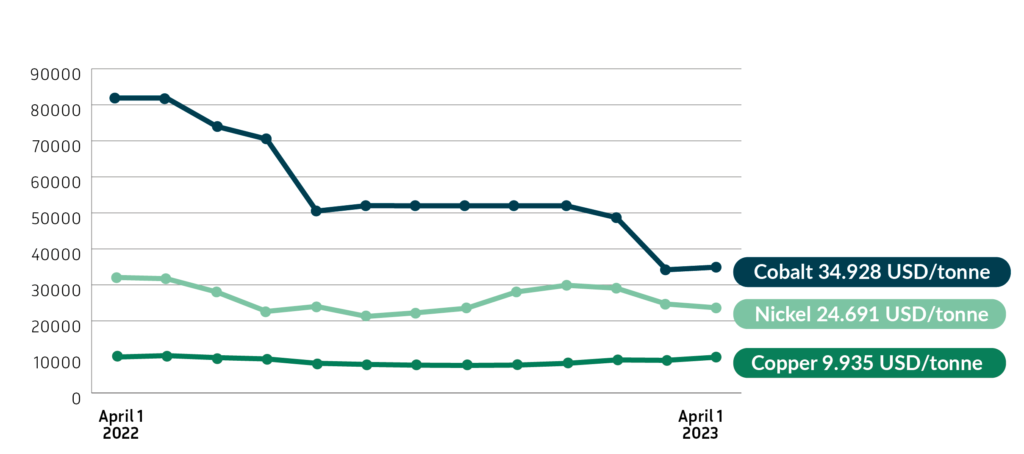6 April, 2023
Newsletter March 2023
Famous German Manager Eckhard Cordes enters Eurobattery Minerals
Prominent and welcome addition to the Eurobattery Minerals family: Eckhard Cordes. The well-known German manager is Chairman of the Supervisory Board of Bilfinger SE, a listed industrial services provider active in the petrochemical, chemical, pharmaceutical, and oil and gas sectors. Among other very important and influential positions Cordes was active as an earlier board member of Daimler AG, Volvo AB and CEO of the Metro trading group. Mr. Cordes is joining our company with a 6-digit euro amount, which I interpret as an honor and confirmation of our business model. Welcome aboard, Mr. Cordes!

Furthermore, the company received approximately SEK 17.4 million (1.54 million EUR) through warrant redemption. I would like to thank all shareholders and new friends for the trust bestowed upon us. With the capital we have just raised, we intend to turn vision in to action and continue the successful development of Hautalampi and Corcel, with the end goal to start mining and supplying Europe with ethical and fully traceable battery minerals.
Finland forecast
Having said that, I would like to draw your attention to our project in Finland, which gives us great pleasure: Hautalampi. Through the pre-feasibility study, we know that the economic prospects for the battery minerals mine in Finland are very good. Therefore, we acquired another 30% of the mine, bringing the total to now 70% with an option to acquire the remaining 30% by June, which is in line with our plan. The project comprises a 227 hectars mining concession with nickel, cobalt and copper deposits. Total metal production during the anticipated 12 years of mining operations will be 11,400 tonnes of nickel, 2,900 tonnes of cobalt in nickel-cobalt concentrate and 9,600 tonnes of in copper concentrate, according to the study. As things stand, Hautalampi will be the first Eurobattery Minerals mine to go into production.

Misunderstood metal: rare earth elements
The green transformation and the need for alternative energies have made rare earths elements (REE) a pop star among the most precious metals of the 21st century. What many people don't know is that rare earths elements are, firstly, not earth raw substances and, secondly, not as rare as their name suggests. The term has grown historically and takes us back to the 18th century, to the time when the chemical elements were found in rare minerals. The name has stayed and, in a way, has its raison d'être today: There are few places in the world with economically exploitable deposits where the concentration is higher than one percent. Along with Russia, Brazil, India and Vietnam, China is now the world's largest producer of this critical mineral. That's problematic because we in Europe are dependent on these countries.
In Fetsjön and Rönnberget, Sweden, we want to counteract this problem with our mining project. The scale of the exploration target is 165,000 to 180,000. tons - or in words: large occurences of REEs. As these first results suggest, with a close to 100% recovery rate, this would mean that we have a very significant rare earth elements deposit in hand, where we could apply a new revolutionary recovery method. We have recently tested this new method in a joint research project with Uppsala University in cooperation with AGH University of Science and Technology in Krakow. The next step will be further tests for detailed characterization of the REE-bearing minerals and possibly a large-scale pilot plant soon.

Raw materials policy has made it to the top of the agenda
"After 18 months of work, it's time to stop being naive and start acting," said Internal Market Commissioner Thierry Breton when he presented the draft Raw Materials Act in mid-March. With the draft and the benchmarks it sets, the European Commission is finally taking an active role in raw materials policy. In the process, the previous list of 30 critical raw materials is extended to 34. Among them, 16 raw materials are designated as strategic in the draft – due to their strategic importance, the ratio of future demand to current global production, and the difficulties in increasing their production; the concrete benchmarks for production capacities within the EU and for import diversification are to apply to them. These include cobalt, copper and rare earths. Other targets are:
- strengthen all stages of the European critical raw materials value chain,
- encourage strategic partnerships and projects,
- use platforms for joint purchasing of raw materials,
- build strategic reserves, stress testing supply chains of critical raw materials and
- speed up procedures for raw materials projects.
This means good prospects for our mining projects! I perceive it as a favorable development that there is an increase in consciousness regarding critical raw materials and that this subject has gained prominence in the highest levels of political discourse. In my conversations with the member of the European Parliament and member of the Committee on Industry, Research and Energy, Hildegard Bentele, we agreed that Europe can no longer afford its "not-in-my-back-yard" mentality and must exploit its own raw material resources. I welcome the regulation and ambition, but we also must do a lot on the local level in the communities to secure people's support and trust.
As you can see, there is a lot happening on our finish line towards the production and sale of sustainably produced battery raw materials. I wish you a sustainable Easter.
Sincerely yours,
Roberto García Martínez, CEO

 Svenska
Svenska
 Deutsch
Deutsch